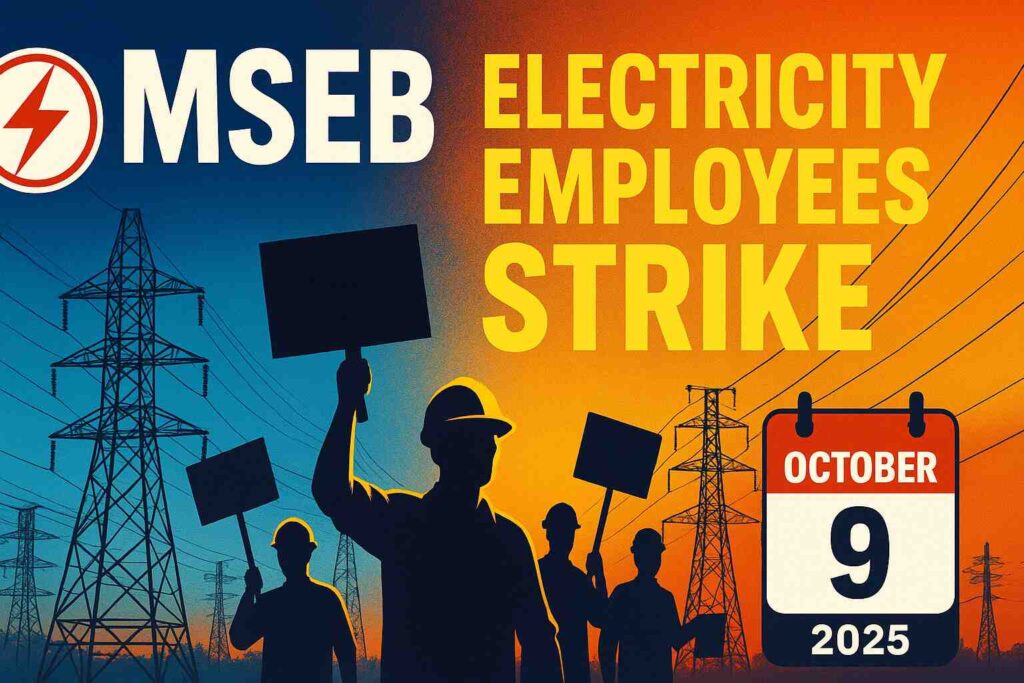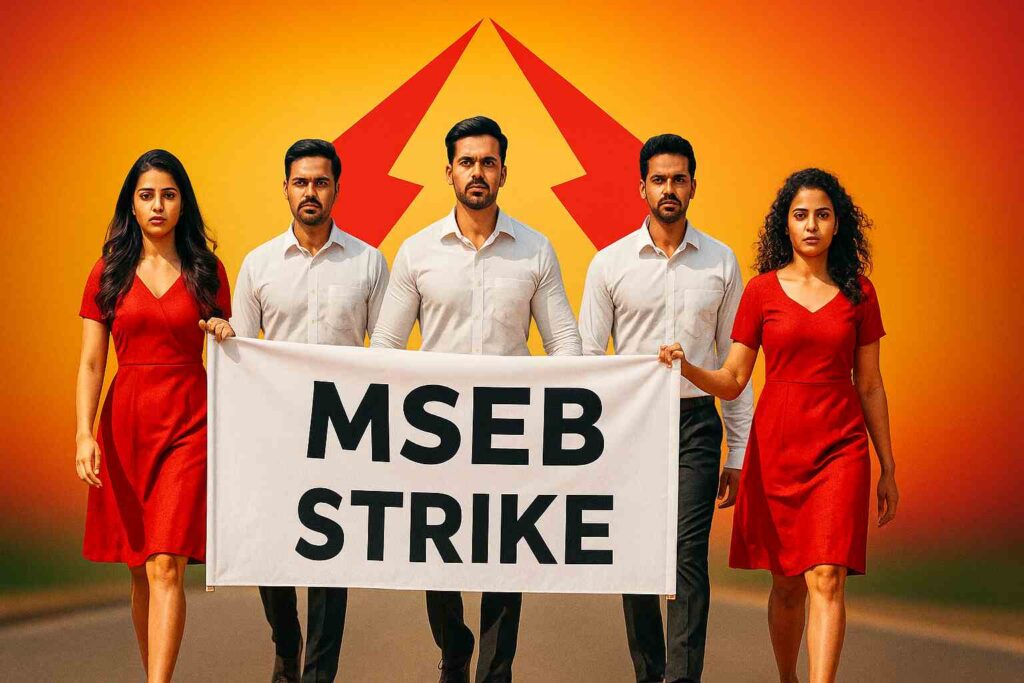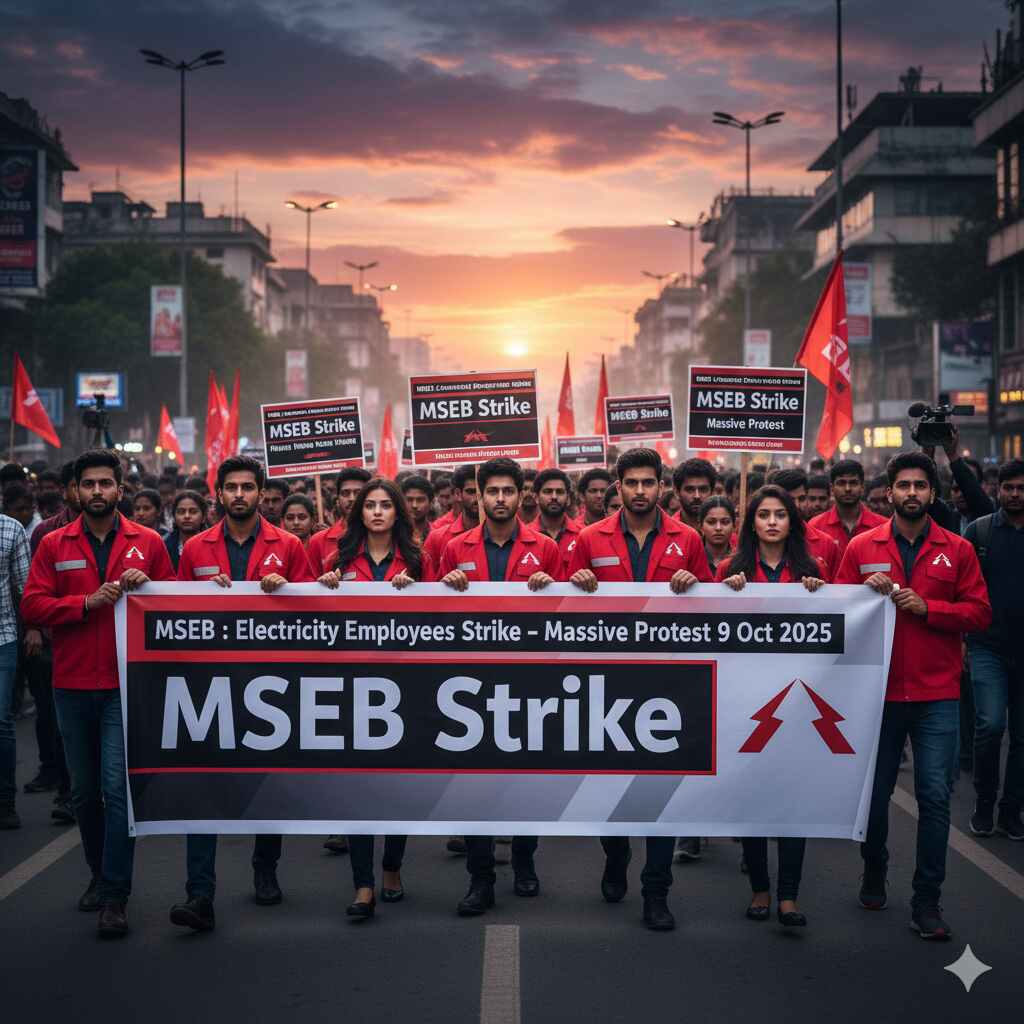Maharashtra is bracing for a major labour action. On October 9, 2025, electricity employees, engineers, officers and contract workers across the state will go on strike to protest the privatization and restructuring of state power companies. The strike call comes from the Maharashtra State Electricity Employee, Engineer & Officer Joint Action Committee, which has warned of a one-day state-wide work stoppage if their demands are not met.
This article outlines the background, issues, demands, possible impact, government response, and what consumers should expect during the strike. The central focus is on the MSEB : electricity employees Strike campaign and its implications.

Table of Contents
MSEB : electricity employees Strike Background: Who Is Striking & Why
- Around 86,000 regular employees (staff, officers, engineers) and 42,000 contract workers are expected to participate in the strike on October 9.
- The action is being driven by opposition to the privatization of Maharashtra’s power sector companies, especially Mahagenco (generation), Mahatransco (transmission) and Mahavitaran / MSEDCL (distribution).
- The unions argue that privatization or “parallel licensing” to private firms (such as Adani, Torrent, etc.) would undermine public control, reduce job security, and allow private players to profit at the expense of consumers.
- In one specific trigger, the Mahavitaran (MSEDCL) management recently announced a restructuring plan. Under this plan, staff would be split into two groups: one handling billing and revenue recovery, and another focusing on operations and maintenance. This is to take effect from October 1, 2025.
- Employee associations oppose this plan because the workforce size will not be increased; employees fear the change will shift more burden onto them, particularly since many divisions are already understaffed.
- Union leaders also claim that privatization efforts are already underway—through granting permits for private firms to distribute electricity in Mahavitaran’s territory, handing over substations to contractors, or pushing IPOs for state electricity companies.
- Another key demand: the immediate implementation of pension and retirement benefit schemes that have been long approved but are still not in effect for many employees.

MSEB : electricity employees Strike Key Demands
The MSEB : electricity employees Strike is built around several core demands:
- Stop privatization / parallel licensing
The workers demand that no private company should be allowed to operate parallel distribution lines within the Mahavitaran / MSEDCL zones. They see this as a backdoor entry for private players to take over parts of the power business. - Halt one-sided restructuring
The proposed splitting of responsibilities (billing vs operations) should not be enforced unilaterally, especially without new recruitment or proper planning. Employees demand a participatory process. - Regularize contract / outsourced workers
The 42,000 contract workers must be absorbed into regular service or given secure employment status. - Implement approved pension / retirement schemes
Many employees say the government has already approved benefits, but actual implementation has been delayed. They demand immediate rollout. - Reverse privatization of generation / transmission projects
Projects in the hydro sector, or those being handed over to private entities, should come back under public control. - Stop handing over substations / infrastructure to private contractors
They demand that existing infrastructure, especially 329 substations proposed for contracting out, be retained under state control.
These demands reflect deep concerns over losing public sector control of essential electricity services, as well as anxiety about job security and benefits for employees.

MSEB : electricity employees Strike Possible Effects & Consumer Impact
Because the strike involves key staff across the electricity network, it may lead to disruptions or delays in some services. Here are likely scenarios and caveats:
- Supply disruptions: In certain localities, power supply may be affected if operation or maintenance staff join the strike. The severity depends on how many personnel join and whether emergency backups are available.
- Delayed services: Meter readings, new connections, approvals, and technical maintenance requests may face delays.
- Contractor work stoppage: Contract workers joining may halt substation maintenance, inspections, or repair work.
- Communication challenges: Helplines may have reduced staff or response delays.
- Critical services: Hospitals, emergency services, and essential public infrastructure may be exempt or prioritized for minimal service continuity.
However, electricity companies often prepare contingency plans in advance. In prior strikes, basic power supply continuation was prioritized in critical zones.
The exact extent of disruption will depend on how many employees, engineers, officers and contract workers fully participate.
Government & Utility Companies’ Position
- The management of Mahavitaran (MSEDCL) claims that the restructuring aims to improve efficiency. The argument is that dedicated personnel for billing and operations will lead to more focused work and better service delivery.
- Officials also insist there will be no reduction of staff strength as part of restructuring.
- On the privatization front, the state government has at times given assurances against wholesale privatizing of power companies. In 2023, then-CM Devendra Fadnavis reportedly pledged that there would be no privatization, and the government would provide financial support of ₹50,000 crore to strengthen power firms.
- Yet, union leaders claim that privatization actions have continued through subtle or indirect mechanisms.
- In earlier actions, Mahavitaran has prepared emergency plans during strike calls to maintain critical power supply.
- The state government and energy departments may engage in last-minute talks with union leaders prior to October 9 to avert full-scale shutdown.

Why the MSEB : electricity employees Strike Matters
This protest is not just an ordinary labour shutdown; it carries larger implications:
- Public vs private control: The strike brings to focus the battle for public ownership of essential services, especially power — a sector with vast economic importance.
- Trade union strength: With 86,000 core employees and many more contract workers joining, this is among the more ambitious collective actions in the state’s recent memory.
- Consumer stakes: While privatization may bring capital and efficiency in some arguments, critics fear it may raise tariffs, reduce accountability, and weaken state control. The strike is a pushback against that.
- Political risk: The government faces a tightrope — tolerating the strike may cause public backlash over power outages, while coercive action could escalate political conflict with labour unions.
- Precedent setting: How the government handles this strike may set tone for future labour relations in sectors like water, transport, etc.
MSEB : electricity employees Strike Timeline & Key Events So Far
- October 1, 2025: Management intends to begin implementing restructuring of MSEDCL staff into distinct roles for billing and operations. The Times of India
- October 9, 2025: The date of the strike across the Maharashtra power sector, involving employees, engineers, officers, and contract workers.
- In earlier episodes, in July 2025, six out of 23 MSEDCL unions called for a one-day strike over labour issues — a precursor to the October action.
- Over preceding weeks, the state-level unions and Joint Action Committee have been meeting, issuing notices, mobilizing staff in various districts, and preparing support strategies.
What Should Consumers Do during MSEB : electricity employees Strike?
- Plan ahead
If you have pending electricity requests (new connection, meter reading, etc.), try to complete them before October 9 or expect delays. - Record power usage carefully
Maintain logs of your meter reading, especially if automatic reading is delayed. - Stay informed
Watch public notices from MSEDCL / Mahavitaran for official bulletins about outages, restoration priorities, or emergency lines. - Use complaint mechanisms
In case of service interruption, use the official helplines or grievance portals — though response might slow. - Emergency preparedness
Critical institutions (e.g. hospitals, schools, water supply) should make backup power plans for October 9. - Spread awareness
Consumers can be sympathetic to the staff’s grievances. Awareness campaigns or media pressure may influence government decisions.
MSEB : electricity employees Strike Challenges & Risks
- Partial participation
If many staffers decide not to join the strike, its impact will be limited. - Government clampdowns
The state may use legal or administrative measures (e.g. invoking essential services laws) to force workers back. - Public backlash
Prolonged outages may upset ordinary citizens who may view unions as responsible. The unions will need to maintain a narrative of legitimacy. - Negotiation last minute
The government may try to reach a deal at the eleventh hour to postpone or dilute the strike. - Unclear enforcement
If contract workers are less organized or coerced, full-scale stoppage may not happen uniformly.
Final Thought on MSEB : electricity employees Strike
The MSEB : electricity employees Strike on October 9, 2025, is a significant event in Maharashtra’s labour and power sector history. Tens of thousands of workers are staking their livelihoods to oppose privatization, demand job security, and assert public control over power utilities. The success or failure of this strike could reshape how energy is managed in the state.
For now, consumers and stakeholders watch closely: will the state government back down, commit to dialogue, or enforce operations with minimal staff? October 9 could be a turning point in the struggle over Maharashtra’s electricity future.
Disclaimer
The information presented in this article is based on publicly available reports and statements from relevant authorities, organizations, and stakeholders as of October 9, 2025. The publication does not guarantee the accuracy, completeness, or timeliness of the content and assumes no legal responsibility for any actions taken based on it. This article is intended for general informational purposes only and should not be construed as professional, legal, or official advice. Readers are advised to verify details through official government or utility communications before relying on or acting upon the information provided.

